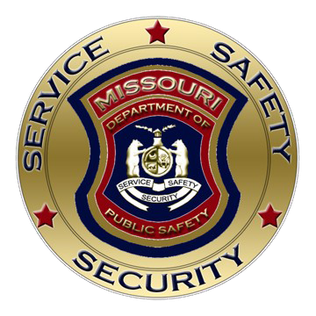
The United States Department of Homeland Security (DHS) is the U.S. federal executive department responsible for public security, roughly comparable to the interior or home ministries of other countries. Its stated missions involve anti-terrorism, border security, immigration and customs, cyber security, and disaster prevention and management.

Federal Emergency Management Agency (FEMA) is an agency of the United States Department of Homeland Security (DHS), initially created under President Jimmy Carter by Presidential Reorganization Plan No. 3 of 1978 and implemented by two Executive Orders on April 1, 1979. The agency's primary purpose is to coordinate the response to a disaster that has occurred in the United States and that overwhelms the resources of local and state authorities. The governor of the state in which the disaster occurs must declare a state of emergency and formally request from the President that FEMA and the federal government respond to the disaster. The only exception to the state's gubernatorial declaration requirement occurs when an emergency or disaster takes place on federal property or to a federal asset—for example, the 1995 bombing of the Alfred P. Murrah Federal Building in Oklahoma City, Oklahoma, or the Space Shuttle Columbia in the 2003 return-flight disaster.
An office of emergency management (OEM), alternatively called an emergency management office (EMO), or an emergency management agency (EMA) in some areas, is an agency at the local, tribal, state, federal, or international level that holds responsibility for comprehensively planning for and responding to and recovering from all manner of disasters, whether man-made or natural. An OEM may also be requested to provide consequence management for large special events such as major gatherings, visiting dignitaries, damage assessment following a disaster, etc.

Emergency management or disaster management is a science and a system charged with creating the framework within which communities reduce vulnerability to hazards and cope with disasters. Emergency management, despite its name, does not actually focus on the management of emergencies, which can be understood as minor events with limited impacts and are managed through the day-to-day functions of a community. Instead, emergency management focuses on the management of disasters, which are events that produce more impacts than a community can handle on its own. The management of disasters tends to require some combination of activity from individuals and households, organizations, local, and/or higher levels of government. Although many different terminologies exist globally, the activities of emergency management can be generally categorized into preparedness, response, mitigation, and recovery, although other terms such as disaster risk reduction and prevention are also common. The outcome of emergency management is to prevent disasters and where this is not possible, to reduce their harmful impacts.

The Robert T. Stafford Disaster Relief and Emergency Assistance Act is a 1988 United States federal law designed to bring an orderly and systematic means of federal natural disaster assistance for state and local governments in carrying out their responsibilities to aid citizens. Congress's intention was to encourage states and localities to develop comprehensive disaster preparedness plans, prepare for better intergovernmental coordination in the face of a disaster, encourage the use of insurance coverage, and provide federal assistance programs for losses due to a disaster.
The Massachusetts Emergency Management Agency (MEMA) is the agency of the Commonwealth of Massachusetts that coordinates federal, state, local, and private resources throughout the Commonwealth during times of disasters and emergencies.
The Florida Division of Emergency Management (DEM) is charged with maintaining a comprehensive statewide program of emergency management. The division ensures that Florida is prepared to respond to emergencies, recover from them, and mitigate their impacts. DEM is responsible for the State Emergency Response Team (SERT) which is composed of various intergovernmental entities, volunteers, and the private sector. The division coordinates the efforts of the Federal Government with other departments and agencies of state government, with county and municipal governments and school boards, and with private agencies that have a role in emergency management. The Director is appointed by the Governor of Florida, and serves as an agency head. Kevin Guthrie currently serves as the Director. He was appointed by Governor Ron DeSantis in May 2021.
Citizen Corps is a program under the Department of Homeland Security that provides training for the population of the United States to assist in the recovery after a disaster or terrorist attack. Each local Citizen Corps Council partners with organizations, volunteers and businesses to organize responders, volunteers and professional first responders for an efficient response so efforts are not wasted by being duplicated. By training in Incident Command, volunteers know whom to report to and how the incident is organized. This prevents sites from being inundated by untrained and unprepared personnel preventing operation. Citizen Corps also works in conjunction with the Corporation for National and Community Service in promoting national service opportunities for promoting homeland security needs.
CaliforniaVolunteers is the state agency charged with increasing the number and impact of Californians engaged in service and volunteering.

The Oklahoma Department of Emergency Management (OEM) is a department of the government of Oklahoma responsible for coordinating the response to a natural disaster that has occurred in the State and that has overwhelmed the abilities of local authorities. This is achieved primarily through the development and maintenance of a comprehensive statewide emergency management plan. OEM is responsible for coordinating the efforts of the federal government with other state departments and agencies, county and municipal governments and school boards, and with private agencies that have a role in emergency management.
The Oklahoma Emergency Management Act of 2003 is an Oklahoma state law that replaced the Oklahoma Civil Defense and Emergency Resources Management Act of 1967 as the primary state law detailing emergency management in Oklahoma. The Emergency Management Act and the Catastrophic Health Emergency Powers Act together form the primary state laws regarding emergency and disastrous situations that may occur in the state.

The Oklahoma Office of Homeland Security (OKOHS) is an agency of State of Oklahoma that is responsible for reducing the State's vulnerability to acts of terrorism and for minimizing and recovering the damage caused by terrorist attacks. OKOHS is a division of the Oklahoma Department of Public Safety.

Nancy L. Ward is the Director of the California Governor's Office of Emergency Services and Homeland Security Adviser to the Governor of California. Previously, Ward served in the Federal Emergency Management Agency (FEMA) as the Regional Administrator for Region IX from 2006 until 2014. During this time, from January until May of 2009, Ward was selected to serve as FEMA's Acting Administrator by her predecessor, R. David Paulison to serve in his place after he retired on January 21, 2009. She returned to the position of Region IX Administrator in May 2009 after Craig Fugate was appointed as Federal Administrator.

The Administration for Strategic Preparedness and Response (ASPR) is an operating agency of the U.S. Public Health Service within the Department of Health and Human Services that focuses preventing, preparing for, and responding to the adverse health effects of public health emergencies and disasters. Its functions include preparedness planning and response; building federal emergency medical operational capabilities; countermeasures research, advance development, and procurement; and grants to strengthen the capabilities of hospitals and health care systems in public health emergencies and medical disasters. The office provides federal support, including medical professionals through ASPR’s National Disaster Medical System, to augment state and local capabilities during an emergency or disaster.

The Department of Public Safety of the State of Missouri, commonly known as the Missouri Department of Public Safety (DPS), is a department of the state government of Missouri.

The Adjutant General of Kansas is the highest-ranking military official in the State of Kansas and is subordinate to the Governor of Kansas. The Adjutant General is a member of the Governor's Cabinet and advises the Governor on military and emergency management matters. The Adjutant General runs the day-to-day administration of the Kansas Adjutant General's Department, including the Kansas National Guard.

Homeland Security Grant Program (HSGP) is a program in the United States established in 2003 and was designated to incorporate all projects that provide funding to local, state, and Federal government agencies by the Department of Homeland Security. The purpose of the grants is to purchase surveillance equipment, weapons, and advanced training for law enforcement personnel in order to heighten security. The HSGP helps fulfill one of the core missions of the Department of Homeland Security by enhancing the country's ability to prepare for, prevent, respond to and recover from potential attacks and other hazards. The HSGP is one of the main mechanisms in funding the creation and maintenance of national preparedness, which refers to the establishment of plans, procedures, policies, training, and equipment at the Federal, State, and local level that is needed to maximize the ability to prevent, respond to, and recover from major events such as terrorist attacks, major disasters, and other emergencies. The HSGP's creation stemmed from the consolidation of six original projects that were previously funded by the Office of State and Local Government Coordination and Preparedness. The HSGP now encompasses five projects in the program: State Homeland Security Program, Urban Areas Security Initiative, Operation Stonegarden, Metropolitan Medical Response System Program, and Citizen Corps Program. During the 2010 fiscal year, the Department of Homeland Security will spend $1,786,359,956 on the Homeland Security Grant Program.
The Stephenson Disaster Management Institute at Louisiana State University is located in the Stephenson National Center for Security Research and Training at LSU.

The Tennessee Emergency Management Agency (TEMA) is an agency of Tennessee government tasked with preparing for and responding to natural and man-made disasters across the state of Tennessee. The agency is headquartered in Nashville, Tennessee. TEMA is a component of the Tennessee Military Department, along with the Tennessee National Guard and the Tennessee State Guard.

The South Dakota Department of Public Safety (DPS) is a state agency in South Dakota, United States. DPS is an enforcement, licensing and services agency that develops and operates programs in the areas of law enforcement, traffic safety, fire safety, driver's licenses, emergency management, and public safety information. The Secretary of Public Safety is appointed by the Governor of South Dakota.












